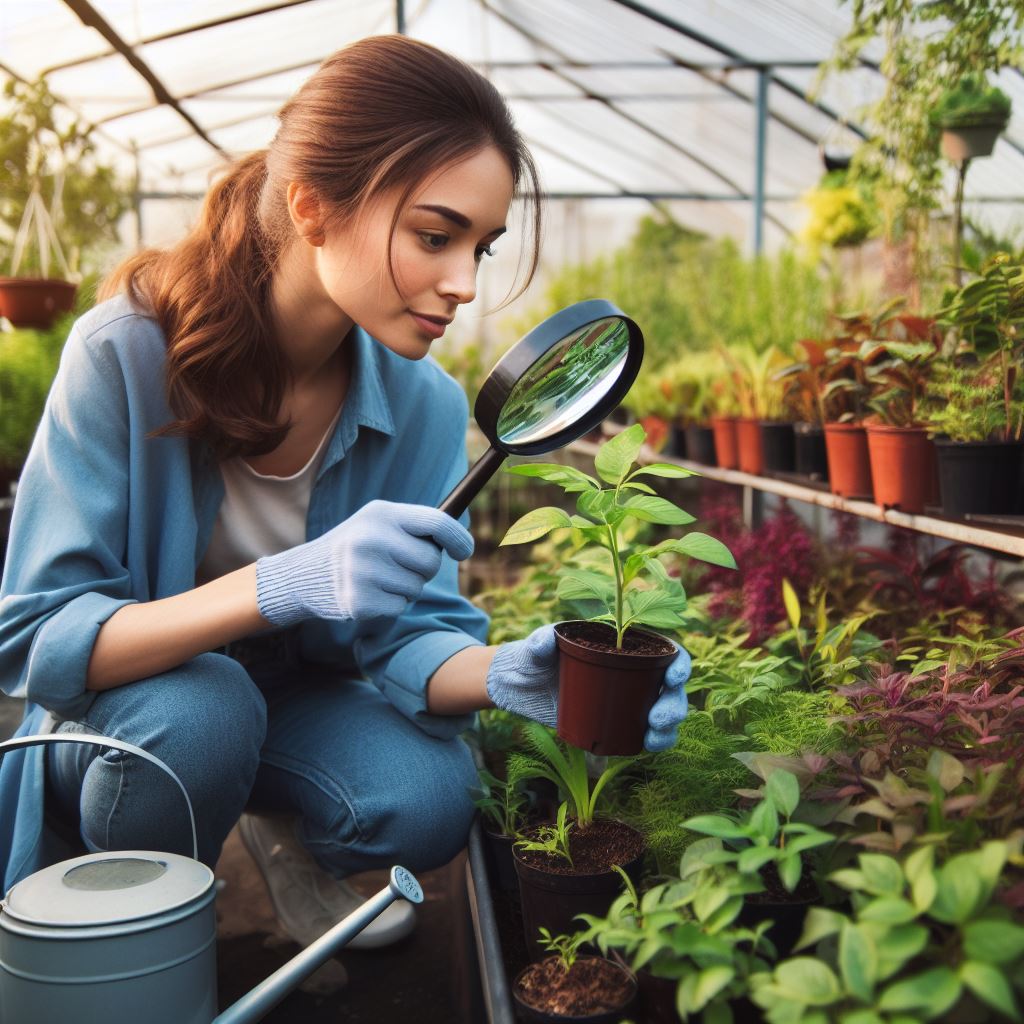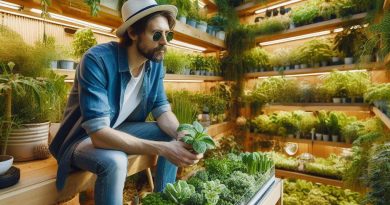Greenhouse Gardening in Urban Spaces
Last Updated on March 2, 2024
Introduction
Greenhouse gardening involves growing plants in a controlled environment, providing optimal conditions for their growth.
Urban spaces are crucial for gardening as they offer limited space and accessibility for individuals who lack outdoor areas.
Greenhouse gardening in urban areas has many advantages, including year-round cultivation, protection from extreme weather, and efficient use of resources.
In this section, we will discuss the factors to consider when choosing the right greenhouse for urban spaces.
Choosing the Right Greenhouse
Size and space considerations
Determine the available space in your urban area to determine the appropriate size of the greenhouse.
Consider the height of the greenhouse to accommodate tall plants and allow proper ventilation.
Ensure there is enough space around the greenhouse for easy access and maintenance.
Material options and sustainability features
Consider using sustainable materials like recycled plastic or reclaimed wood for the greenhouse structure.
Choose materials that provide good insulation to regulate temperature and save energy.
Look for options with UV protection to prevent damage from harsh sunlight.
Cost and maintenance factors to consider
Evaluate your budget for a greenhouse within financial limits.
Consider long-term maintenance costs, automated features, and space for urban suitability.
Assess available urban space for an appropriate size, ensuring a comfortable fit. Also, consider the height for ventilation and plant needs.
Prioritize eco-friendly materials like recycled plastic for sustainability, durability, and strength.
Choose insulation for temperature regulation and UV protection for plant and structure preservation.
Factor in cost and long-term maintenance; opt for low-maintenance features to save time and money.
In summary, choose a greenhouse considering size, materials, sustainability, cost, and maintenance for a successful urban gardening experience. Happy gardening!
Read: Farm-to-Table: Growing Your Own Food
Selecting Suitable Plants for Urban Greenhouses
Understanding the limitations of urban spaces
- Consider the limited space available in urban areas when selecting plants for your greenhouse.
- Acknowledge that urban greenhouses may not have access to direct sunlight for extended periods.
- Recognize the need for plants that can thrive in controlled environments with limited natural resources.
Selecting plants that require minimal space and light
- Choose plants with compact growth habits that won’t take up too much space in your urban greenhouse.
- Opt for plants that can tolerate lower light levels, as urban environments may have shading from tall buildings.
- Consider plants that don’t require excessive pruning or training to fit within a limited space.
- Ensure the selected plants can still produce a satisfactory yield or provide aesthetic value despite space constraints.
Different plant varieties suitable for small-scale greenhouse gardening
- Tomatoes: Select compact varieties like ‘Cherry Cascade’ or ‘Window Box Roma’ for urban greenhouses.
- Lettuce: Opt for leafy greens such as ‘Black Seeded Simpson’ or ‘Buttercrunch’ that grow well in containers.
- Herbs: Choose herbs like basil, parsley, and chives that require minimal space and can be grown indoors.
- Microgreens: Consider growing nutrient-dense microgreens, like broccoli and radish, for a small-scale greenhouse.
- Peppers: Look for dwarf pepper varieties like ‘Patio Pride’ or ‘Tequila’ that are well-suited for urban greenhouses.
- Cucumbers: Select bush cucumber varieties such as ‘Bush Champion’ or ‘Patio Snacker’ that thrive in containers.
- Strawberries: Opt for compact strawberry varieties like ‘Alpine Yellow’ or ‘Mignonette’ for limited space.
- Flowers: Explore flowering plants such as pansies, marigolds, or petunias that add beauty to your urban greenhouse
By carefully selecting suitable plants for your urban greenhouse, you can maximize the limited space available while still enjoying a fruitful and visually appealing garden.
Read: Heirloom vs. Hybrid: What’s Best for You?
Creating the Ideal Environment for Greenhouse Gardening
Greenhouse gardening in urban spaces requires careful attention to creating the ideal environment for plants.
Here are some key factors to consider:
Climate control and temperature regulation
- Invest in a reliable climate control system to maintain optimal temperatures for plant growth.
- Monitor and regulate the temperature inside the greenhouse to ensure plants are not subjected to extreme heat or cold.
- Utilize heating systems during cooler months and shading techniques during hotter months.
- Install thermometers and automatic temperature control devices for precision and convenience.
Maximizing natural light and optimizing artificial lighting
- Place the greenhouse in an area that receives maximum sunlight exposure throughout the day.
- Clean the greenhouse glazing regularly to allow ample natural light to penetrate.
- Install reflective surfaces or materials to ensure light is evenly distributed among plants.
- Supplement natural light with artificial lighting, especially during shorter daylight hours or cloudy days.
- Use energy-efficient LED grow lights that emit the right spectrum for different plant stages.
Proper ventilation and air circulation techniques
- Provide proper ventilation to avoid heat buildup and prevent excessive humidity levels.
- Install vents, louvers, or exhaust fans to encourage air movement and prevent stagnant air.
- Implement an automated system for controlling ventilation and air circulation.
- Consider using natural ventilation methods, such as ridge vents and sidewall vents, to reduce energy consumption.
- Position fans strategically to ensure air is evenly distributed within the greenhouse.
Creating the ideal environment for greenhouse gardening ensures the success and productivity of your plants.
By carefully managing climate control and temperature regulation, maximizing natural and artificial lighting, and implementing proper ventilation and air circulation techniques, you can create a thriving urban greenhouse garden.
Remember to regularly monitor and adjust these factors to meet the specific needs of your plants and local climate conditions.
Investing time and effort into creating the perfect environment will reward you with healthy, vibrant plants and bountiful harvests throughout the year.
Read: Herbs & Spices: Growing Your Flavor Garden

Effective Watering and Irrigation Systems
Effective watering and irrigation systems play a crucial role in the success of greenhouse gardening in urban spaces.
Determining the water requirements of greenhouse plants
- Different plants have varying water needs, so it is important to understand the specific requirements of each species.
- Factors such as plant type, growth stage, temperature, and humidity influence the water requirements.
- Conducting research, consulting with experts, and referring to plant-specific guides can help determine water needs.
Choosing the right irrigation system for urban greenhouses
- Drip irrigation systems are popular due to their ability to provide precise water delivery directly to the plant’s roots.
- Micro-sprinklers and misting systems are suitable for cultivating delicate plants that thrive in high humidity.
- Automated irrigation systems, equipped with timers and sensors, offer convenience and efficiency for urban gardeners.
Conserving water and implementing smart watering practices
- Mulching the soil helps retain moisture, reduces evaporation, suppresses weeds, and improves water distribution.
- Collecting rainwater in barrels or using greywater for irrigation reduces reliance on freshwater sources.
- Installing water-efficient devices like flow restrictors and drip irrigation regulators minimizes wastage.
- Monitoring soil moisture levels using moisture meters or sensor-based systems prevents overwatering and saves water.
- Proper scheduling of irrigation based on plant requirements and weather conditions prevents water stress.
- Implementing a regular maintenance schedule for irrigation systems ensures they function optimally and prevent leaks.
In Short, understanding the water requirements of greenhouse plants, choosing the appropriate irrigation system, and conserving water through smart practices are vital aspects of successful urban greenhouse gardening.
By employing these strategies, gardeners can maximize productivity and minimize the environmental impact of their activities.
Read: Vertical Gardening: Maximize Your Yield
Managing Pests and Diseases in Urban Greenhouses
Identifying common pests and diseases in greenhouse gardening
- Aphids: Small insects that feed on plant sap and can cause stunted growth and wilting.
- Whiteflies: Tiny, white insects that suck sap from leaves and can transmit plant diseases.
- Spider mites: Microscopic pests that damage plants by sucking out their juices, causing discoloration.
- Fungal diseases: Common diseases include powdery mildew, botrytis, and damping-off.
- Bacterial infections: Bacterial wilt, leaf spot, and bacterial blight can affect greenhouse plants.
Implementing organic pest control methods
- Biological control: Introduce beneficial insects like ladybugs and lacewings to eat pests.
- Neem oil: A natural pesticide that repels pests without harming the plants or beneficial insects.
- Insecticidal soap: Kills soft-bodied insects like aphids, thrips, and whiteflies upon contact.
- Seaweed spray: Enhances plant health and resistance to pests and diseases.
- Companion planting: Grow pest-repelling plants like marigolds and basil alongside vulnerable crops.
Preventive measures to minimize the risk of infestation
- Regular monitoring: Inspect plants regularly to detect early signs of pest or disease infestation.
- Proper watering: Avoid overwatering, as it can create a humid environment ideal for pests and diseases.
- Good ventilation: Ensure proper airflow to reduce humidity and prevent the spread of diseases.
- Cleanliness: Remove fallen leaves, weeds, and debris that can harbor pests and diseases.
- Quarantine: Isolate new plants for a few days to check for any signs of infestation before introducing them to the greenhouse.
By being vigilant and implementing preventive measures, urban greenhouse gardeners can effectively manage pests and diseases without relying on chemical pesticides.
Identifying common pests such as aphids, whiteflies, and spider mites is crucial in taking prompt action.
Implementing organic pest control methods like biological control, neem oil, and insecticidal soap can help keep pests at bay without harming the environment.
Preventive measures, such as regular monitoring, proper watering, good ventilation, cleanliness, and quarantine, can significantly minimize the risk of infestation.
Regularly inspecting plants for any signs of pests or diseases allows gardeners to address issues before they become widespread.
Proper watering and ventilation create an unfavorable environment for pests and diseases, as they thrive in damp conditions.
Ensuring cleanliness by removing fallen leaves, weeds, and debris eliminates potential hiding places for pests and diseases.
Quarantining new plants before introducing them to the greenhouse allows gardeners to observe for any signs of infestation before risking the health of other plants.
Ultimately, managing pests and diseases in urban greenhouses requires a proactive approach and a combination of preventive measures and organic pest control methods.
By practicing integrated pest management techniques, urban greenhouse gardeners can maintain healthy and thriving plants while preserving the ecological balance in their urban spaces.
Urban Composting and Soil Management
Exploring composting options for limited spaces
Composting is an essential practice for urban gardeners, even with limited space available.
- Consider using a compost bin specifically designed for urban spaces.
- Vermicomposting, using worms to break down organic matter, is an excellent option for small areas.
- Explore bokashi composting, which allows you to ferment kitchen scraps in a sealed container.
- Utilize compost tumblers, which are compact and easy to manage in urban settings.
Importance of maintaining healthy soil in urban greenhouses
Healthy soil is the foundation for productive greenhouse gardening in urban areas.
- A well-balanced soil composition ensures proper nutrient availability for plant growth.
- It improves water retention and drainage, crucial for greenhouse plants in limited spaces.
- Healthy soil promotes beneficial microbial activity and suppresses harmful pathogens.
- Good soil structure provides a stable root system and supports overall plant health.
Using organic fertilizers and soil amendments to improve soil quality
Organic fertilizers and soil amendments are vital for enhancing soil quality in urban greenhouse gardens.
- Choose organic fertilizers rich in nutrients that are available in slow-release forms.
- Apply compost, aged manure, or organic matter to increase organic content and improve soil structure.
- Add perlite or vermiculite to enhance soil aeration and water drainage capabilities.
- Utilize beneficial soil amendments like biochar or seaweed extracts to enhance soil fertility.
By actively managing composting and soil quality, urban greenhouse gardeners can ensure successful and sustainable gardening practices within limited spaces.
Maximizing Space and Organization in Urban Greenhouses
A well-organized and space-efficient greenhouse is essential for successful greenhouse gardening in urban spaces.
With limited area available, it is important to utilize every inch effectively.
Here are some techniques and ideas to help you maximize space and keep your urban greenhouse organized:
Vertical gardening techniques for small spaces
- Utilize vertical space by growing plants on trellises, arbors, or walls.
- Train vine crops to grow vertically using stakes or cages, freeing up ground space.
- Invest in hanging planters or wall-mounted pockets to grow herbs and small vegetables.
- Consider using hydroponic or aeroponic systems that allow vertical growth without soil.
Utilizing hanging baskets, shelves, and plant stands
- Hang baskets from the ceiling or overhead structures to grow trailing plants.
- Install floating or wall-mounted shelves to create additional storage and display space.
- Use tiered plant stands to grow multiple plants in a compact arrangement.
- Hang planters or shelves near windows for natural light exposure.
Implementing efficient storage and organization solutions
- Install hooks or pegboards on walls to hang gardening tools and equipment.
- Use labeled bins or stackable containers to store seeds, fertilizers, and other supplies.
- Consider installing a workbench or table for potting and organizing plants.
- Utilize vertical wall space with mounted hooks or racks to hang hoses and irrigation systems.
- Invest in compact, foldable furniture for easy storage and space flexibility.
With these space-saving techniques and organization solutions, you can make the most of your urban greenhouse and create a productive and visually appealing gardening space.
Discover More: Grow Strong: Natural Disease Prevention
Connecting with the Urban Gardening Community
A sense of community is essential for urban greenhouse gardeners to thrive.
By connecting with like-minded individuals, you can learn from their experiences and gain valuable knowledge and insights.
Here are some ways to connect with the urban gardening community:
Joining Local Gardening Clubs and Communities
Find local gardening clubs or communities in your area and become a member.
These groups typically hold regular meetings and activities where you can interact with fellow urban greenhouse gardeners.
It’s an opportunity to share ideas, ask questions, and build meaningful connections.
Participating in Urban Gardening Events and Workshops
Keep an eye out for urban gardening events and workshops happening around your city.
These events attract passionate gardeners who are eager to share their expertise.
By attending these gatherings, you can meet new people, learn new techniques, and get inspiration for your greenhouse garden.
Sharing Experiences and Tips with Fellow Urban Greenhouse Gardeners
Online platforms and forums dedicated to urban gardening provide a space for gardeners to connect virtually.
Join these communities to share your own experiences, ask for advice, and learn from others who have faced similar challenges.
It’s a great way to build a network of fellow greenhouse enthusiasts.
Connecting with the urban gardening community offers several benefits:
- Inspiration: Interacting with fellow gardeners can spark your creativity and inspire new ideas for your own greenhouse garden. You’ll always find something exciting happening in the community.
- Knowledge Sharing: Each gardener brings their unique experiences and expertise to the table. By sharing tips, tricks, and lessons learned, everyone can elevate their gardening skills.
- Support Network: Gardening can sometimes be challenging, especially for beginners. Being part of a community means you have a support system to turn to when you encounter difficulties and need guidance.
- Access to Resources: The urban gardening community is often well-connected, with members having access to a wide range of resources. From seeds and plants to tools and equipment, you may benefit from sharing or borrowing these resources.
- Friendship and Camaraderie: Building relationships with fellow gardeners can lead to lifelong friendships. You’ll find like-minded individuals who share your passion and can celebrate your gardening milestones together.
Remember, connecting with the urban gardening community is a two-way street.
Actively participate, contribute, and engage with others. Share your knowledge generously and be open to learning from those around you.
Together, you can create a thriving urban gardening community where everyone can flourish!
Find Out More: Ergonomic Gardening Tools for Easier Work
Conclusion
Throughout this blog post, we have explored the world of greenhouse gardening in urban spaces.
From the countless benefits to the endless possibilities, it is clear that this is a practice worth considering for anyone living in an urban area.
Firstly, greenhouse gardening allows for year-round cultivation, regardless of the external weather conditions.
This means that you can enjoy fresh produce even in the depths of winter, eliminating the need to rely on imported and often less nutritious fruits and vegetables.
Secondly, urban gardening in greenhouses promotes sustainability.
By growing your own food, you reduce your carbon footprint by minimizing transportation and packaging waste.
Additionally, you have control over the use of pesticides and fertilizers, ensuring that your food is healthy and environmentally friendly.
Greenhouse gardening has significant well-being benefits.
It provides a peaceful and therapeutic escape from the hustle and bustle of urban life.
Gardening has been proven to reduce stress, improve mental health, and promote physical activity.
I urge you to give greenhouse gardening a try in your own urban environment.
You don’t need a large yard or a vast amount of space; even a small balcony can accommodate a mini-greenhouse or vertical garden.
Start small and experiment with herbs or leafy greens, and gradually expand your garden as you gain confidence and experience.
Greenhouse gardening in urban spaces is a sustainable and fulfilling activity that offers numerous benefits.
It empowers individuals to take charge of their own food production, reap the rewards of well-being, and contribute to a greener future.
So why not give it a try and transform your urban space into a thriving garden oasis!


